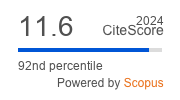IOT AUDIO SENSOR NETWORKS AND DECISION TREES FOR ENHANCED RAIN SOUND CLASSIFICATION
DOI:
https://doi.org/10.29284/ijasis.10.1.2024.35-44Keywords:
Acoustic sensing, environmental acoustics, IoT deployment, classification algorithms, rainfall patterns, data analytics, sensor fusion, ecological research.Abstract
Accurately classifying rain sounds is essential in the field of climate investigation and environmental monitoring for understanding rainfall patterns, intensity, and how it affects ecosystems and urban infrastructure. This research presents a new method for rain sound classification combines decision trees (DTs) algorithms with networks of Internet of Things (IoT) audio sensors. To record ambient noises, particularly those caused by precipitation, the system makes use of a dispersed network of inexpensive IoT audio sensors placed in different places. A DTs algorithm, trained on a broad dataset including varying rain intensities and background sounds, is then applied by a central processing unit (CPU) to these recordings. When compared to more conventional approaches, experimental findings show the technique significantly improves rain sound classification accuracy, especially when it comes to differentiating between moderate and mild rain sounds and ambient noise. Automated weather alarm systems, urban drainage management, agricultural planning, and real-time rainfall monitoring are some of the potential uses for the proposed system. It helps advance environmental science, meteorology, and smart city projects by using IoT and machine learning to provide more accurate and faster rainfall data, which is essential for infrastructure planning and decision-making.
References
H. Cheng, S. Liu and J. Zhang, “Lightweight Scene-aware Rain Sound Simulation for Interactive Virtual Environments,” IEEE Conference Virtual Reality and 3D User Interfaces (VR), 2023, pp. 226-236.
B. Basnyat, N. Roy, A. Gangopadhyay and A. Raglin, “Environmental Sound Classification for Flood Event Detection,” 18th International Conference on Intelligent Environments, Biarritz, France, 2022, pp. 1-8.
A. Ahmed, Y. Serrestou, K. Raoof and J. -F. Diouris, “Sound event classification using neural networks and feature selection based methods,” IEEE International Conference on Electro Information Technology, 2021, pp. 1-6.
A. Emmanuel, B. Guda, N. D. Hailemariam, M. S. Meshach and I. T. Barnabas, “Machine Learning Based Rain Gauge Using Acoustic Data,” IEEE AFRICON, 2023, pp. 1-4.
X. Wang, M. Wang, X. Liu, T. Glade, M. Chen, Y. Xie, and Y. Chen, “Rainfall observation using surveillance audio,” Applied Acoustics, vol. 186, 2022, pp. 1-12.
N.P. Prayuda, A.P. Firmansyah, R.S. Sandy, P. Paduloh, “Flood Management System Using a Sound Sensor Arduino Based. International Journal of Society reviews, vol. 2, no. 1, 2022, pp. 237-244.
D.K. Sah, K. Cengiz, N. Ivković, A. Gehlot, and B. Salah, “Acoustic signal-based indigenous real-time rainfall monitoring system for sustainable environment,” Sustainable Energy Technologies and Assessments, vol. 60, 2023, pp. 1-12.
H. Guo, H. Huang, Y. -E. Sun, Y. Zhang, S. Chen and L. Huang, “Chaac: Real-Time and Fine-Grained Rain Detection and Measurement Using Smartphones,” in IEEE Internet of Things Journal, vol. 6, no. 1, 2019, pp. 997-1009.
H. Palizvan-Zand, A. Ahmadi, and A. Kadkhodaie, “Determining the intensity of rainfall using the analysis of sound frequencies resulting from the impact of raindrops,” Iranian Journal of Soil and Water Research, vol. 54, no. 2, 2023, pp. 319-335.
B.B. Ma, B.D. Dushaw, and B.M. Howe, “Rainfall at sea: Using the underwater sounds of raindrops as a rain gauge for weather and climate,” Acoustics Today, vol. 18, no. 2, 2022, pp. 1-10.
J. Guo, C. Li, Z. Sun, J. Li, and P. Wang, “A Deep Attention Model for Environmental Sound Classification from Multi-Feature Data,” Applied Sciences, vol. 12, no. 12, 2022, pp. 1-11.
J.K.A. Tan, Y. Hasegawa, and S.K. Lau, “A comprehensive environmental sound categorization scheme of an urban city,” Applied Acoustics, vol. 199, 2022, pp. 1-12.
B.Y. Ooi, J.J. Lim, S.Y. Liew, and S. Shirmohammadi, “Remote operation status tracking for manufacturing machines via sound recognition using IoT,” IEEE International Instrumentation and Measurement Technology Conference, 2022, pp. 1-6.
M. Mahyub, L. S. Souza, B. Batalo, and K. Fukui, “Environmental Sound Classification Based on CNN Latent Subspaces,” International Workshop on Acoustic Signal Enhancement, 2022, pp. 1-5.
S. Kawale, D. Dhabliya, and G. Yenurkar, “Analysis and Simulation of Sound Classification System Using Machine Learning Techniques,” International Conference on Emerging Trends in Engineering and Medical Sciences, 2022, pp. 407-412.
A. Bevilacqua, F. Merli, G. Iannace and L. Tronchin, "A rain of sound from the double elliptical vault inside the monumental stairwell of the Reggia of Caserta," Immersive and 3D Audio: from Architecture to Automotive, 2021, pp. 1-5.
G. Karuna, S. Daliyet, and D. V. V. Reddy, “IoT-based Sun and Rain Detection System,” In E3S Web of Conferences, vol. 391, 2023, pp. 1-12.
Downloads
Published
Issue
Section
License
Copyright (c) 2024 Kamalakannan Machap, Sandeep. R. Narani

This work is licensed under a Creative Commons Attribution 4.0 International License.
This work is licensed under a Creative Commons Attribution 4.0 International License, which permits unrestricted use, distribution, and reproduction in any medium, provided the original work is properly cited.











